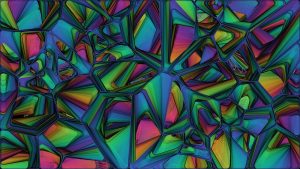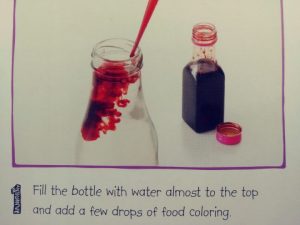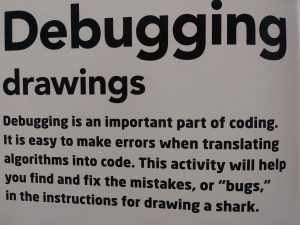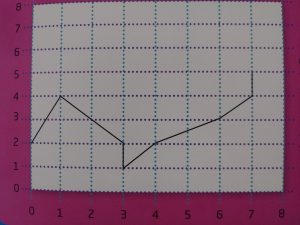wednesday june 24
Inertia: a property of matter by which it remains at rest or in uniform motion in the same straight line unless acted upon by some external force (Merriam-Webster Dictionary).
Have a look at this picture from accuweather.com. This meteorologist, Jason Nicholls is about to hit the side of the plate. What do you think will happen? Hypothesize about what will happen to the egg and why?

Now watch the video and observe what actually does happen…
Why didn’t the egg smash on the table? Short answer; inertia; Isaac Newton’s First Law of Motion, which states that an object at rest remains at rest and an object in motion remains in motion with the same velocity (speed of something in a given direction) unless acted upon.
“The plate and tube will go in the direction of the force applied to the plate when Jason smacked it, but that force doesn’t affect the egg. Instead, inertia will keep the egg in place until gravity pulls the egg straight down into the glass.
In the world of weather, inertia is one of the reasons why you are able to jump in ocean waves this summer.” (accuweather.com)
Pretty cool hey? Now if you want to try this at home yourself, you may want to try it outside! Have fun with inertia!
wednesday june 17
Anyone up for making some of your own custom made bracelets? Find out how to bend these craft sticks to create a curved bracelet ready for your own creative designer jewelry, HERE, from figmentcreativelabs.com
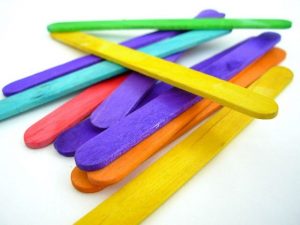
wednesday may 27
It’s getting warmer outside and the temperature is rising. This week’s STEAM experiment is called “Thermometer” from “Smithsonian Maker Lab Outdoors: 25 Super Cool Projects” by Jack Challoner.
A thermometer measures how hot or cold something is. In this activity, you will make a simple liquid thermometer using colored water.
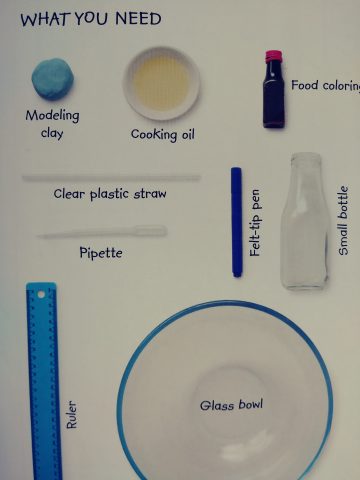
Make sure you collect all the materials before you start.

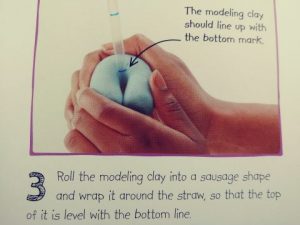
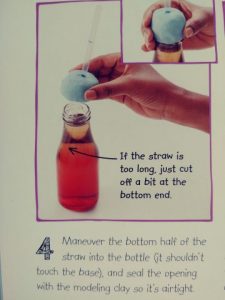
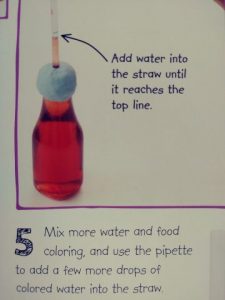
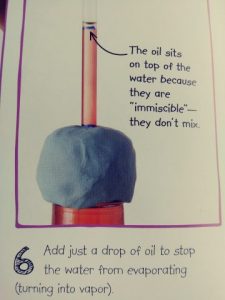
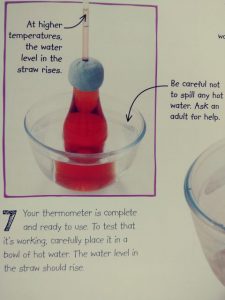
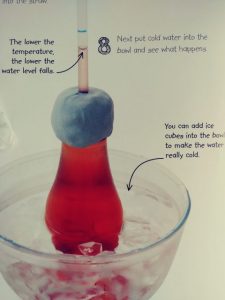
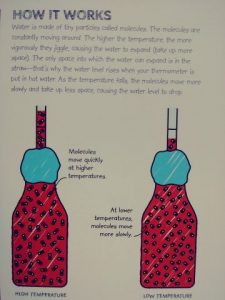
Wednesday may 20
This week’s STEAM activity is also from the Burnaby Advanced Learning website by John Spencer. Click here to see other activities offered on the website or have a look at your challenge below!
“Design a school on mars”
Your challenge is to design and build a model school for people who are goin to colonize Mars. Yes, the planet Mars! Create a blueprint, student handbook, and model of your school. Be sure to think about realistic ratios for sizing and measurements! If you want a sneak peek at Mars, click HERE for a 360 VR look at our “red” planet.
Some questions to consider when planning this are:
Where will your school be located? What considerations must you think about in terms of location?
How will you keep students safe while also making learning challenging?
What are the students there going to learn? What new subjects will they need to study?
How will school on Earth and School on Mars differ? Remain the same?
What special features will the school have? How might this affect your design?
What kind of technology and “gadgets” will the students use? Which are necessary and which are for fun?
What will the learning environment (ie classroom) look like?
What architectural style would best suit school on Mars? Why?
Share your ideas with a family member, or other students and compare your ideas!
wednesday may 13
This week’s STEAM activity is also from the Burnaby Advanced Learning website. Click here to see other activities offered on the website or have a look at your challenge below!
“Lost at the Smithsonian”
You’re at the Smithsonian museum on a field trip with your class and suddenly realize you have no idea where your class is! You must find your group soon or you will miss the bus and be left behind. Use the virtual tour and complete the puzzles to navigate your way around and find your classmates! Click below to start!
wednesday may 6
This week’s STEAM activity is from the Burnaby Advanced Learning website. Click here to see other activities offered on the website or have a look at your challenge below!
Toy Troubles
Challenge: Design a machine to pick up and sort Lego (or other small toys) so they can be put away easily. Create a blueprint or diagram that labels each part. Use materials you have at home and create a model of your machine. If possible, see if you can get your machine to work.
Lower Intermediate: Label any simple machines (lever, inclined plane, wedge, pulley, wheel and axle, screw) that are used in your device.
Upper Intermediate: Which of Newton’s three laws of motion are present and where?
Did you include any moving parts on your machine? What types of materials could you use to make the parts work?
How would you change your device structure if the toys were a different size?
Wednesday april 29
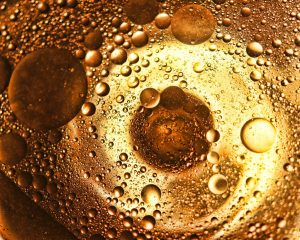
Today’s activity comes from Science-Sparks.com. You can click here or follow the instructions below to test out the density of various liquids.
What you need: Glass jar or large transparent glass, various liquids, food coloring (if you choose to color the different liquids)
What to do: List the liquids you would like to test and what color they are. Pour ALL the liquids in the same jar and wait! Eventually the liquids will settle into layers with the liquid with the highest density on the bottom. They liquid with the lowest density will be on the top!
Questions: In what situation would knowing the density of liquids be useful? What might happen is two liquids have approximately the SAME density?
wednesday april 22
This week’s STEAM activity comes from “How To Be A Coder” by Kiki Prottsman, published by DK in 2019.
Do you love computers? Do you code? Do you enjoy solving problems?
See if you can DEBUG the wrong code in this grid drawing activity:
1. Fold a paper in half 3 times. Unfold it and fold it the other way 3 times to make a grid pattern on your paper. 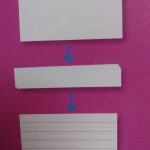

2. Number your grid lines on the x and y axis. Remember the x axis is horizontal, and the y axis is vertical. Draw a line from 0,2 (x,y) to 1,4 (x,y). 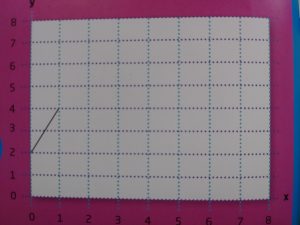
3. Your next point is diagonally to 3,2.
Then to 3,1.
Proceed to 4,2.
Now to 6,3 and then 7,4.
Then up to 7,5.
Does your drawing look like this one above? If yes, then you’re doing great! Take a look at the next set of “code”.
4. Go diagonally to point 6,6 and across to 4,6.
Then to 3,4 and then to 3,6.
Now to 1,5 and finish at 0,1.
Does your drawing look right? What do you reckon the drawing is of? That’s right, it should be in the shape of a shark!!! What went wrong? Go back and see what ‘coding’ was incorrect and see if you can debug it with the correct code to complete the drawing!
wednesday april 15
Do you have any left over Halloween Candy? Want a fun and creative way to use it and eat it? This activ
ity requires the use of the oven, so ask your parents for supervision intermediates! Click the link or read below!
CRUSHED CANDY STAINED GLASS
SAFETY TIPS AND HINTS
Adult supervision is required for this experiment. Melted candy is very hot and sticky and can cause burns.
Wear protective eyeware when hammering the candy.
Cookie cutters with simple shapes that sit flat on a baking sheet work best for this project.
MATERIALS
Oven
Clear, colorful, hard candy
Small zippered plastic bags (1 bag for each color of candy)
1 large zippered plastic bag
Protective glasses
Hammer
Baking sheet
Nonstick cooking spray 5 5 to 10 cookie cutters
PROTOCOL
1. Preheat the oven to 350°F
2. Unwrap the hard candy and sort it by color (fig. 1).
3. Put each color of candy in its own small zippered plastic bag and seal the bags. Put all the small bags into one larger zippered bag. Seal the larger bag. 4. Put on your protective glasses and crush the candy with a hammer (fig. 2).
5. Store the crushed candy in the freezer until you’re ready to use it.
6. Coat a baking sheet with cooking spray.
7. Arrange the cookie cutters on the prepared baking sheet and spray them lightly with cooking spray. 8. Fill the cookie cutters with different colors of crushed candy until about 1/2 inch
9. Put the baking sheet in the oven for 5 minutes or until the candy melts and looks like stained glass (fig. 4).
10. Remove the baking sheet from the oven and let the candy cool completely. 11. Carefully remove the candy stained glass from the cookie cutters
THE STEAM BEHIND THE FUN:
Most clear hard candy has what food scientists call a glass structure. Rather than individual sugar crystals like you see in table sugar and rock candy, it has a disorganized structure. When hard candy is made, corn syrup (glucose and fructose) is added to melted table sugar (sucrose) to keep sugar molecules from crystalizing. The long sugar chains in the corn syrup interfere with crystal formation, so hard candy remains clear and glasslike when it cools.
This activity is from STEAM Lab for Kids at Quartoknows.com
Stained glass art has been around since the Middle Ages. Unlike hard candy, real glass is made from silicon dioxide—the main component of sand.
Hi Intermediates,
Have a go at some of these but ensure your parents or guardians at home know what you’re doing! It can sometimes be messy or need resources that require extra safety precautions so be sure to communicate with your parents and guardians before you begin, and ask for help where needed!
AND have fun!
So, you have some extra time and need some extension activities?
Well you’ve come to the right place. Mrs Stocker is posting fun STEAM activity each week on WEDNESDAYS for you to try out at home.
TRIVIA TIME: What does S-T-E-A-M stand for? See below for some clues!!!



